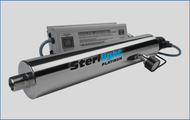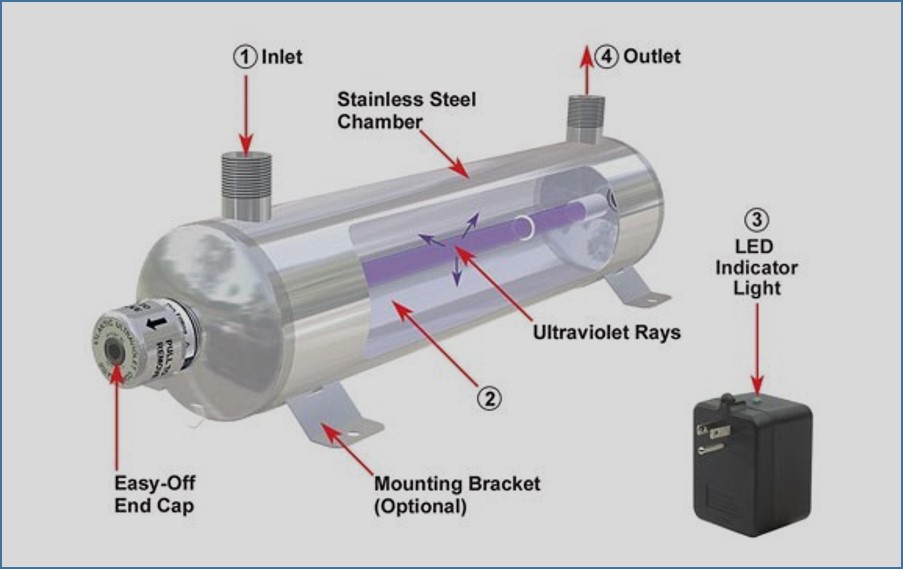What is UV Disinfection System - How it Works, Components, Benefits
Posted by David Cannon on 25th Mar 2020

Access to pure drinking water has been one of the necessities of humankind. This is achieved through various disinfection methods such as filtration, chlorination, UV disinfection, and so on. Among the various methods, UV disinfection has emerged as the most effective method of all. Amongst the many water cleaning technologies, the UV disinfectant system is the most effective one. This is a disinfection technology that utilizes invisible light that is the Ultraviolet (UV) radiations to disinfect microorganisms effectively. As this technology is being used extensively, it is important to understand its function. This post explains the UV disinfectant system of water followed by its function.
What is UV Radiation?
Prior to getting into the UV disinfectant system, it is mandatory to understand what exactly the UV light is. To be precise, ultraviolet (UV) light is the spectrum of light that is invisible to human eyes. This spectrum falls between the x-rays and visible light, as the range of its wavelength is from 200 to 300 nanometers. Natural UV light is mostly absorbed by the Ozone layer, yet the accessible UV radiations have the potential to terminate the growth of microorganisms like chlorine immune protozoa, bacteria, and so on. The UV light is also referred to as germicidal due to its anti-microbial property. Now, letâs understand the UV disinfectant system of water and its function.
Introduction to UV Disinfectant System
As discussed earlier, the UV light has a germicidal wavelength that can terminate the growth of microorganisms. In the UV disinfectant system of water, UV radiations of specified wavelengths are incident on the stream of water. As soon as the UV radiation comes in contact with the bacterial contaminants in the water, the germicidal action takes place. The UV radiation stops the infection by terminating the reproduction of bacteria, protozoa, etc. Due to the lack of reproduction, the bacterial strain gets under control and reduces the level of contamination in water. If used in conjunction with hydrogen, the UV radiation can also disinfect water from chemical contaminants.

Gain an Understanding on Components of UV Disinfectant System
The UV disinfectant system features 4 fundamental components, which play an important role in the disinfection activity. The details of these components are as described below.
- Reactor Chamber: The reactor chamber is an enclosed structure made of stainless steel in most applications. The reactor chamber is the casing that houses the other three fundamental components of the UV disinfectant system. The whole process of water purification takes place inside this reactor chamber. Depending on the required flow rate of the UV disinfectant system, the chambers come in different shapes along with different port sizes. Irrespective of the aesthetics of the reactor chambers, all the chambers function the same, as they support or enclose the assembly.
- Ultraviolet (UV) Lamp: Certainly, being a part of a UV disinfectant system, a UV lamp is the most important component here. The UV lamps are installed in the system to radiate the germicidal UV-C wavelength for disinfection. The UV lamps have mercury which may pronounce hazards to mankind, however here it is present in a small quantity, in the size of a bead. Like regular bulbs, the UV lamps are fitted with filaments, which produce an electric current. This current heats the mercury, which evaporates, still remains in the air inside the lamp. This evaporated mercury helps produce electrical arcs, which produce UV radiations of different intensities to disinfect water. There are different types of UV lamps, which are distinguished as below.
- Standard UV lamps: These are low-pressure UV lamps that are used in domestic water disinfection devices.
- High Output UV lamps: These are low pressure but high output UV lamps. These lamps are used for a high flow rate yet they form lower footprints. These lamps are used for high or moderate capacity water disinfection applications.
- Amalgam UV lamps: These are mercury amalgam UV lamps that use vaporized mercury to increase the intensity of UV radiation. These lamps are used in the commercial UV disinfection systems.
- The Quartz Sleeve: The quartz sleeve offers protection to the UV lamp. The lamp is inserted into this long cylindrical tube made of glass to keep it safe from the flow of water.
- Ballast/ Controller Unit: The ballast is a control unit that maintains the electrical output to the UV lamp. The intensity of radiations is varied based on the electrical supply offered by the control unit.
Benefits of UV Disinfectant Systems
UV disinfectant systems offer many benefits, which makes them a safer choice when compared to other methods described at the beginning of this post:
- A Chemical-Free System: The UV disinfectant system of water is a chemical-free system. It does not contaminate water with any chemicals like chlorine. It rather disinfects the water from the chemical contaminations.
- Produces No Carcinogens: Unlike chemical water purification, UV disinfection is not carcinogenic and produces no harmful byproducts.
- There is no immediate maintenance threat: Unlike the chemical disinfectant system, the UV disinfection system has no immediate safety troubles. Once installed, it can be used for a long time as long as all components function effectively.
As of now, the UV disinfectant system is introduced and its working mechanism is detailed, it is certain that you may intend to purchase the system. It is very important to purchase it from an genuine supplier like Cannon Water Technology, Inc. The Company has been supplying quality water purifying equipment from brands like Lakos, Myron L, etc.
